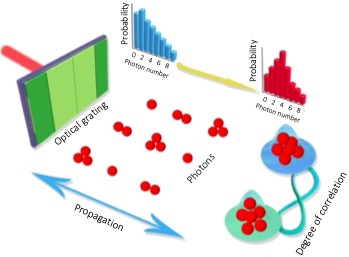Scientists Discover Light Conversion in Free Space

Chenglong You, LSU Research Assistant Professor
LSU quantum researchers demonstrate the possibility of producing different forms of light through propagation in free space— a manifestation of the quantum van Cittert-Zernike theorem.
For almost a century, the description of the evolution of the quantum properties of coherence for optical systems through the van Cittert-Zernike theorem have remained elusive.
In new findings published in Nature npj Quantum Information, a team of researchers from Louisiana State University and the National Autonomous University of Mexico demonstrate that the statistical fluctuations of the electromagnetic field, which define different kinds of light, can be modified upon propagation, leading to the modification of its quantum properties of coherence.
The theoretical study entitled “Multiphoton quantum van Cittert-Zernike Theorem” involves collaborative research from Chenglong You, research assistant professor, Ashe Miller, Phd researcher and Omar Magana-Loaiza, associate professor from the LSU Quantum Photonics Laboratory, along with Roberto de J. León-Montiel, associate professor, UNAM’s Institute of Nuclear Sciences.
“Remarkably, the van Cittert-Zernike theorem has constituted one of the pillars of classical optics for almost a century” said Magana-Loaiza. “This fundamental theorem provides the formalism to describe the modification of the classical coherence properties of optical fields upon propagation. However, the description of the evolution of the quantum properties of coherence of optical systems through the van Cittert-Zernike theorem had remained elusive.”
The research team applied their theoretical formalism to a multiphoton system. Interestingly, this kind of system can host many complex forms of interference processes that are essential to perform operations which are intractable on classical systems.
Notably, their publication provides a theoretical formalism to describe the modification of the quantum fluctuations of multiphoton systems upon propagation in the absence of conventional light-matter interactions. Furthermore, this work uncovers the possibility of performing all-optical preparation of multiphoton systems with attenuated quantum statistics below the shot-noise limit.
The attenuation of the quantum fluctuations of optical fields has enormous implications for the design of diverse quantum technologies ranging from quantum sensing to quantum information processing.
This work was supported by the Army Research Office (ARO), through the Early Career Program (ECP) under the grant no. W911NF-22010-088 and by DGAPA-UNAM under the Project UNAM-PAPIIT IN101623.
###
Contact: Mimi LaValle
External Relations Manager
LSU Physics & Astronomy
225-439-5633
mlavall@lsu.edu